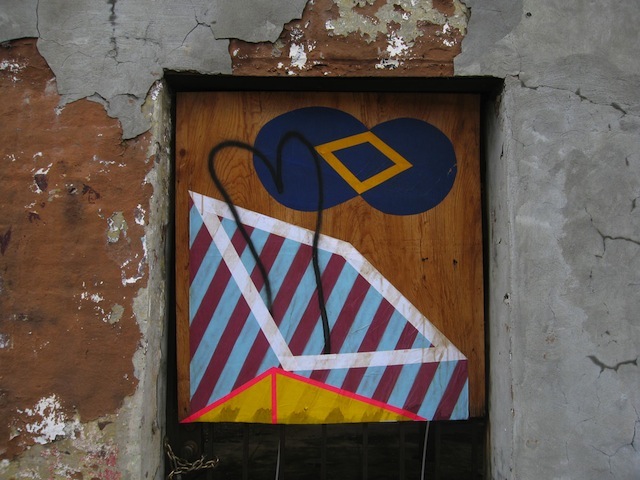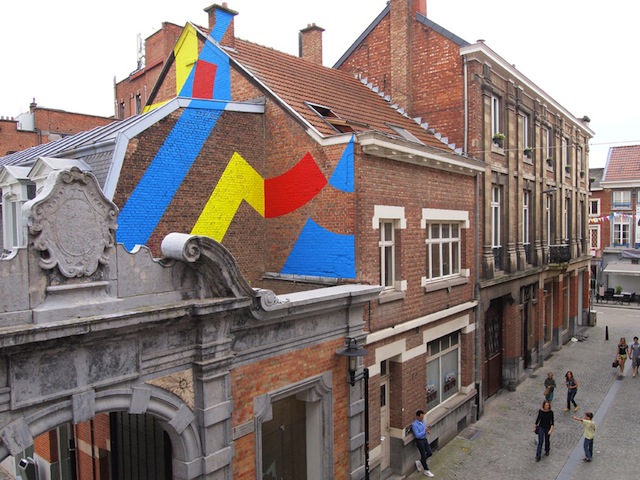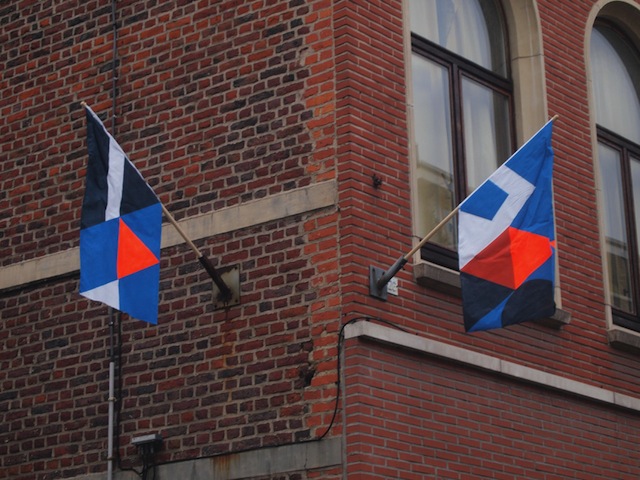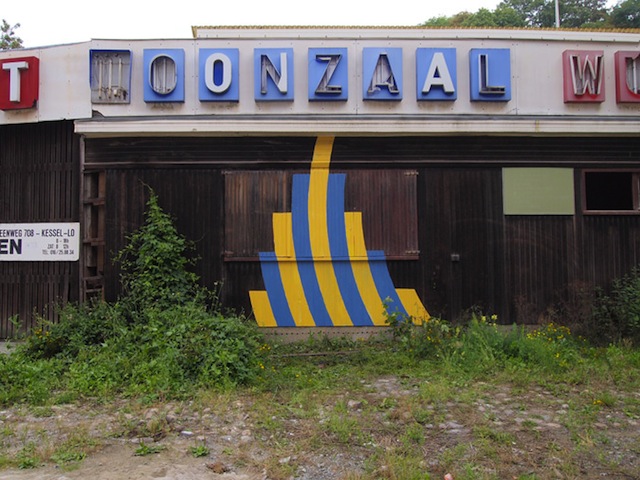
Last month, I saw an installation by MOMO here in Philadelphia at Space 1026. Seeing the installation made me fall in love with MOMO all over again. Some of the first pieces of street art I ever noticed around London were his abstract wheatpastes, which stood out among a sea of logos and figures as something different and fresh. Since then, MOMO has been the artist whose work I think best exemplifies successful abstract street art. With street art, there is a tendency for galleries, blogs, festivals and magazines to stick to “easy” art, but MOMO doesn’t make art that you can look at for two seconds and leave alone. He changes environments. MOMO isn’t just putting up a photoshopped Batman stencil or whatever the kids are doing these days to get some hype. Nevertheless, MOMO has worked with Papermonster, FAME Festival, The Underbelly Project, Anno Domini and more. While staying just outside of this culture’s mainstream, it seems that MOMO has a lot of fans who, like me, keep him in the back of their mind at all times for his ability to push post-graffiti and street art forward and make spaces beautiful. That is to say, here’s an interview with MOMO after the jump…
RJ: What have traditional graffiti writers said about you having the largest tag in Manhattan?
MOMO: I haven’t had that conversation, or if its come up, but I can’t recall anything too unusual.

When you collaborate with El Tono, what is that process like compared to when you work alone?
Working with Eltono, there’s always a great soundtrack, a rootsy adventure, and lots to learn since he’s always steps ahead with techniques, languages, and documentation ideas. Working alone I get into more of a personal revery. That can mean trouble if there’s deadlines and no counter weight, to confirm when you are/are not completely nuts.

How would you describe the experience of handing over a degree of creative control over to a computer, as you did in your MOMO Maker project (and to a lesser extent your recent painting at the Fountainhead Residency)? Is do you not think of it as handing over creative control at all?
Well I would love to see a loss of control, in terms of anti-art, deconstruction, going backwards, spoofing the sublime and so on. The MOMO Maker was originally a joke in this spirit, but was also instantly a very real and useful tool. I’d stumbled into the process of serial art making, which has its own history, but that hasn’t mattered much, it works, like a telescope to see into the unknown. I love making customized tools. There’s no separation between that and the final work.

Who do you hope is the audience for your art? Who do you think it is?
I don’t know. There are so many humans. Its a grand mystery. Doing this in public areas for twelve years has given me fascinating conversations and access to brilliant, remarkable, strange people I would never have met. Like when I was very young and traveled with just enthusiasm and no way in to places, I would hit all the obtuse angles, down and out types, mass entertainment and tourism facades, all wonderful but lonely.

Although there are obvious exceptions (like El Tono and the artists mentioned in the book Abstract Graffiti), most street art tends to be primarily figurative and traditional graffiti is based on typography. Have you found that people react differently to your primarily abstract work than your figurative street art or figurative street art by other artists?
I don’t know what peoples reactions are like, and on most levels I don’t care. If a work is real oblique and people don’t even see it, that’s a plus as it gives me some cover. To create and explore freely, its the long view that counts. You know, to have vision without immediate gratification/confirmation is cool. Haha. Obviously figurative work gets more attention because our brains are wired to spot and read figures, but maybe that doesn’t guarantee its interesting? I have no idea.

In your bio, you use the term “post-graffiti.” What does that mean to you?
I thought I was abusing the term, that it only applied to “tagging with logos”, but have a look at this article by Javier Abarca where he reasons that constantly changing content with a recognizable style is the same idea, letting viewers see pieces as a part of a whole. I do one-off projects, but “post graffiti” works roughly, sounds open ended.

From where you’ve put up your work, it seems like you must love to travel. If you could only either make art or travel the world for the next decade, which would you choose?
Like go to art-only jail vs. travel but only to observe? Could I take tourist photos? Some audio notes-to-self? That would be fine. Luckily, those can’t be separated.
Do you think art school helped or hurt you as an artist?
Its like I did & didn’t go to art school. The North Carolina School of the Arts was great, but just a public/state funded high school experience. The Savannah College of Art & Design was lousy, so I dropped out after a year. Learning is supreme, but getting into debt-slavery over it is a bad idea. Audit classes, read, ask questions, get into weird situations.

When you’re working outdoors, how do you decide where to paste or paint?
Its best when the spot is already interesting. So the less I do, the better. Just pointing to whats already interesting is the ideal, showing it in new ways.
What have you got planned for the future?
Well, I can’t disclose too much… But I am thinking of several zines, one entitled “An Incomplete List of All Things Possible”. I’m enjoying this Robert Write book, “The Evolution of God”, nearly done with that. Last week I sent two large paintings to the Underbelly show in Miami, and moved into a new studio.
Photos by MOMO
